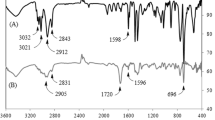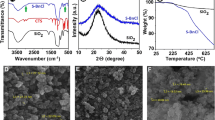Abstract
The aim of this work was to synthesize a novel hydrophilic structure based on polystyrene (PS) cross-linked by using N,N′-(hexane-1,6-diyl)diacrylamide (HDBPA). FT-IR was carried out for chemical structure characterization of HDBPA and cross-linked samples. In addition to FT-IR, 1H NMR was also applied on HDBPA for more investigations. The results showed that HDBPA was synthetized through a condensation reaction, and consequently, it could successfully cross-link PS structure. Moreover, the determination of nitrogen content in HDBPA within PS network was investigated by means of elemental analysis. Afterward, the reactivity ratios between HDBPA and styrene were calculated via Fineman–Ross equation in which the obtained values were 0.66 and 0.23, respectively. On the other hand, by adding the HDBPA to PS the water contact angle was decreased from 73.6° to 57.4°, thereby proving the indispensable role of the cross-linking agent on hydrophilicity of the samples. Finally, the thermal behavior of the samples was studied using DSC and TGA analyses. According to DSC thermograms, there was a shift in Tg up to 30 °C for the samples with cross-linking densities ranging from 2.5 to 20 mol.%. In regard to the thermal stability of the cross-linked samples, the TGA curves revealed a reduction in this property owing to the presence of amide groups in HDBPA through the PS structure.








Similar content being viewed by others
References
Wang T, Zhu H, Xue H (2016) Reversible pH stimulus-response material based on amphiphilic block polymer self-assembly and its electrochemical application. Materials 9(6):478
Sarmento B, Campana-Filho SP, Azevedo C, Almeida A, Silva D (2018) Synthesis and applications of amphiphilic chitosan derivatives for drug delivery applications. In: Neves AR, Reis S (eds) Nanoparticles in life sciences and biomedicine. Pan Stanford, New York, pp 45–73
Oh JY, Kim S, Baik HK, Jeong U (2016) Conducting polymer dough for deformable electronics. Adv Mater 28(22):4455–4461
Zeynep EY, Antoine D, Brice C, Frank B, Christine J (2015) Double hydrophilic polyphosphoester containing copolymers as efficient templating agents for calcium carbonate microparticles. J Mater Chem B 3(36):7227–7236
Gao H, Jones M-C, Chen J, Liang Y, Prud’homme RE, Leroux J-C (2008) Hydrophilic nanoreservoirs embedded into polymeric micro/nanoparticles: an approach to compatibilize polar molecules with hydrophobic matrixes. Chem Mater 20(13):4191–4193
Ansary RH, Awang MB, Rahman MM (2014) Biodegradable poly (D, L-lactic-co-glycolic acid)-based micro/nanoparticles for sustained release of protein drugs-a review. Trop J Pharm Res 13(7):1179–1190
Surmenev R, Chernozem R, Syromotina D, Oehr C, Baumbach T, Krause B, Boyandin A, Dvoinina L, Volova T, Surmeneva M (2019) Low-temperature argon and ammonia plasma treatment of poly-3-hydroxybutyrate films: surface topography and chemistry changes affect fibroblast cells in vitro. Eur Polym J 112:137–145
Garcia-Ivars J, Wang-Xu X, Iborra-Clar M-I (2017) Application of post-consumer recycled high-impact polystyrene in the preparation of phase-inversion membranes for low-pressure membrane processes. Sep Purif Technol 175:340–351
Ma Y, Dai J, Wu L, Fang G, Guo Z (2017) Enhanced anti-ultraviolet, anti-fouling and anti-bacterial polyelectrolyte membrane of polystyrene grafted with trimethyl quaternary ammonium salt modified lignin. Polymer 114:113–121
Hannon JC, Kerry JP, Cruz-Romero M, Azlin-Hasim S, Morris M, Cummins E (2017) Kinetic desorption models for the release of nanosilver from an experimental nanosilver coating on polystyrene food packaging. Innov Food Sci Emerg Technol 44:149–158
Okano T, Yamada N, Sakai H, Sakurai Y (1993) A novel recovery system for cultured cells using plasma-treated polystyrene dishes grafted with poly (N-isopropylacrylamide). J Biomed Mater Res 27(10):1243–1251
Hwang S-J, Tseng M-C, Shu J-R, Yu HH (2008) Surface modification of cyclic olefin copolymer substrate by oxygen plasma treatment. Surf Coat Technol 202(15):3669–3674
Qu J-B, Liu Y, Liu J-Y, Huan G-S, Wei S-N, Li S-H, Liu J-G (2018) One-pot synthesis of bimodal gigaporous polystyrene microspheres with hydrophilic surfaces. Macromolecules 51(11):4085–4093
Fekete N, Béland AV, Campbell K, Clark SL, Hoesli CA (2018) Bags versus flasks: a comparison of cell culture systems for the production of dendritic cell–based immunotherapies. Transfusion 58(7):1800–1813
Borisova O, Billon L, Zaremski M, Grassl B, Bakaeva Z, Lapp A, Stepanek P, Borisov O (2012) Synthesis and pH-and salinity-controlled self-assembly of novel amphiphilic block-gradient copolymers of styrene and acrylic acid. Soft Matter 8(29):7649–7659
Oikonomou EK, Bethani A, Bokias G, Kallitsis JK (2011) Poly (sodium styrene sulfonate)-b-poly (methyl methacrylate) diblock copolymers through direct atom transfer radical polymerization: influence of hydrophilic–hydrophobic balance on self-organization in aqueous solution. Eur Polym J 47(4):752–761
Luo T, Lin S, Xie R, Ju X-J, Liu Z, Wang W, Mou C-L, Zhao C, Chen Q, Chu L-Y (2014) pH-responsive poly (ether sulfone) composite membranes blended with amphiphilic polystyrene-block-poly (acrylic acid) copolymers. J Membr Sci 450:162–173
Richard M-N, Bell M, Srinivasan R, Borhan A, Nagarajan R (2019) An approximate analytical approach to estimate the diffusivity of toxic chemicals in polymer barrier materials from the time evolution of sessile drop profiles. Polym Bull 76:339–364
Sharmin E, Zafar F (eds) (2012) Polyurethane. In: Polyurethane an introduction. InTechOpen, London, pp 3–16
Modarresi-Saryazdi SM, Haddadi-Asl V, Salami-Kalajahi M (2018) N, N’-methylenebis (acrylamide)-crosslinked poly (acrylic acid) particles as doxorubicin carriers: a comparison between release behavior of physically loaded drug and conjugated drug via acid-labile hydrazone linkage. J Biomed Mater Res Part A 106(2):342–348
Kong J, Yu S (2007) Fourier transform infrared spectroscopic analysis of protein secondary structures. Acta Biochim Biophys Sin 39(8):549–559
Mu B, Shen R, Liu P (2009) Crosslinked polymeric nanocapsules from polymer brushes grafted silica nanoparticles via surface-initiated atom transfer radical polymerization. Colloids Surf B 74(2):511–515
Ma Y, Jiang Y, Tan H, Zhang Y, Gu J (2017) A rapid and efficient route to preparation of isocyanate microcapsules. Polymers 9(7):274
Yang H, Yan R, Chen H, Lee DH, Zheng C (2007) Characteristics of hemicellulose, cellulose and lignin pyrolysis. Fuel 86(12–13):1781–1788
Abraham RJ, Griffiths L, Perez M (2013) 1H NMR spectra. Part 30: 1H chemical shifts in amides and the magnetic anisotropy, electric field and steric effects of the amide group. Magn Reson Chem 51(3):143–155
Nikdel M, Salami-Kalajahi M, Hosseini MS (2014) Synthesis of poly (2-hydroxyethyl methacrylate-co-acrylic acid)-grafted graphene oxide nanosheets via reversible addition–fragmentation chain transfer polymerization. RSC Adv 4(32):16743–16750
Yu L, Xu K, Ge L, Wan W, Darabi A, Xing M, Zhong W (2016) Cytocompatible, Photoreversible, and Self-Healing Hydrogels for Regulating Bone Marrow Stromal Cell Differentiation. Macromol Biosci 16(9):1381–1390
Fineman M, Ross SD (1950) Linear method for determining monomer reactivity ratios in copolymerization. J Polym Sci 5(2):259–262
Strobel M, Lyons C (2011) An essay on contact angle measurements. Plasma Process Polym 8(1):8–13
Pal P, Singh S-K, Mishra S, Pandey J-P, Sen G (2019) Gum ghatti based hydrogel: microwave synthesis, characterization, 5-Fluorouracil encapsulation and ‘in vitro’drug release evaluation. Carbohydr Polym 222:114979
Pal P, Pandey J, Sen G (2018) Sesbania gum based hydrogel as platform for sustained drug delivery: an ‘in vitro’study of 5-Fu release. Int J Biol Macromol 113:1116–1124
Pal P, Pandey J-P, Sen G (2017) Modified PVP based hydrogel: synthesis, characterization and application in selective abstraction of metal ions from water. Mater Chem Phys 194:261–273
Ueberreiter K, Kanig G (1950) Second-order transitions and mesh distribution functions of cross-linked polystyrenes. J Chem Phys 18(4):399–406
Yamasaki R, Endo T (2013) Synthesis and polymerization of styrene monomer carrying isothiocyanate moiety and its copolymerization with HEMA based on chemo-selectivity to nucleophiles. J Polym Sci Part A Polym Chem 51(24):5215–5220
Delman A, Stein A, Simms B (1967) Synthesis and thermal stability of structurally related aromatic Schiff bases and acid amides. J Macromol Sci Chem 1(1):147–178
Wu HS, Chuang MH, Hwang JW (1999) Kinetics and thermal analysis of copolymerization of m-isopropenyl–α, α′-dimethylbenzyl isocyanate with styrene. J Appl Polym Sci 73(13):2763–2770
Uhl FM, Levchik GF, Levchik SV, Dick C, Liggat JJ, Snape C, Wilkie CA (2001) The thermal stability of cross-linked polymers: methyl methacrylate with divinylbenzene and styrene with dimethacrylates. Polym Degrad Stab 71(2):317–325
Hsieh W-h, Cheng W-t, Chen L-c, Lin S-y (2018) Non-isothermal dehydration kinetic study of aspartame hemihydrate using DSC, TGA and DSC-FTIR microspectroscopy. Asian J Pharm Sci 13(3):212–219
Arrieta MP, López J, López D, Kenny J, Peponi L (2015) Development of flexible materials based on plasticized electrospun PLA–PHB blends: structural, thermal, mechanical and disintegration properties. Eur Polym J 73:433–446
Funding
The authors received no specific funding for this work.
Author information
Authors and Affiliations
Corresponding author
Ethics declarations
Conflict of interest
The authors declare that they have no conflict of interest.
Additional information
Publisher's Note
Springer Nature remains neutral with regard to jurisdictional claims in published maps and institutional affiliations.
Rights and permissions
About this article
Cite this article
Modarresi-Saryazdi, S.M., Rahmani, S. & Zahedi, P. Hydrophilic modification and cross-linking of polystyrene using the synthesized N,N′-(hexane-1,6-diyl)diacrylamide. Polym. Bull. 78, 1379–1391 (2021). https://doi.org/10.1007/s00289-020-03161-z
Received:
Revised:
Accepted:
Published:
Issue Date:
DOI: https://doi.org/10.1007/s00289-020-03161-z




